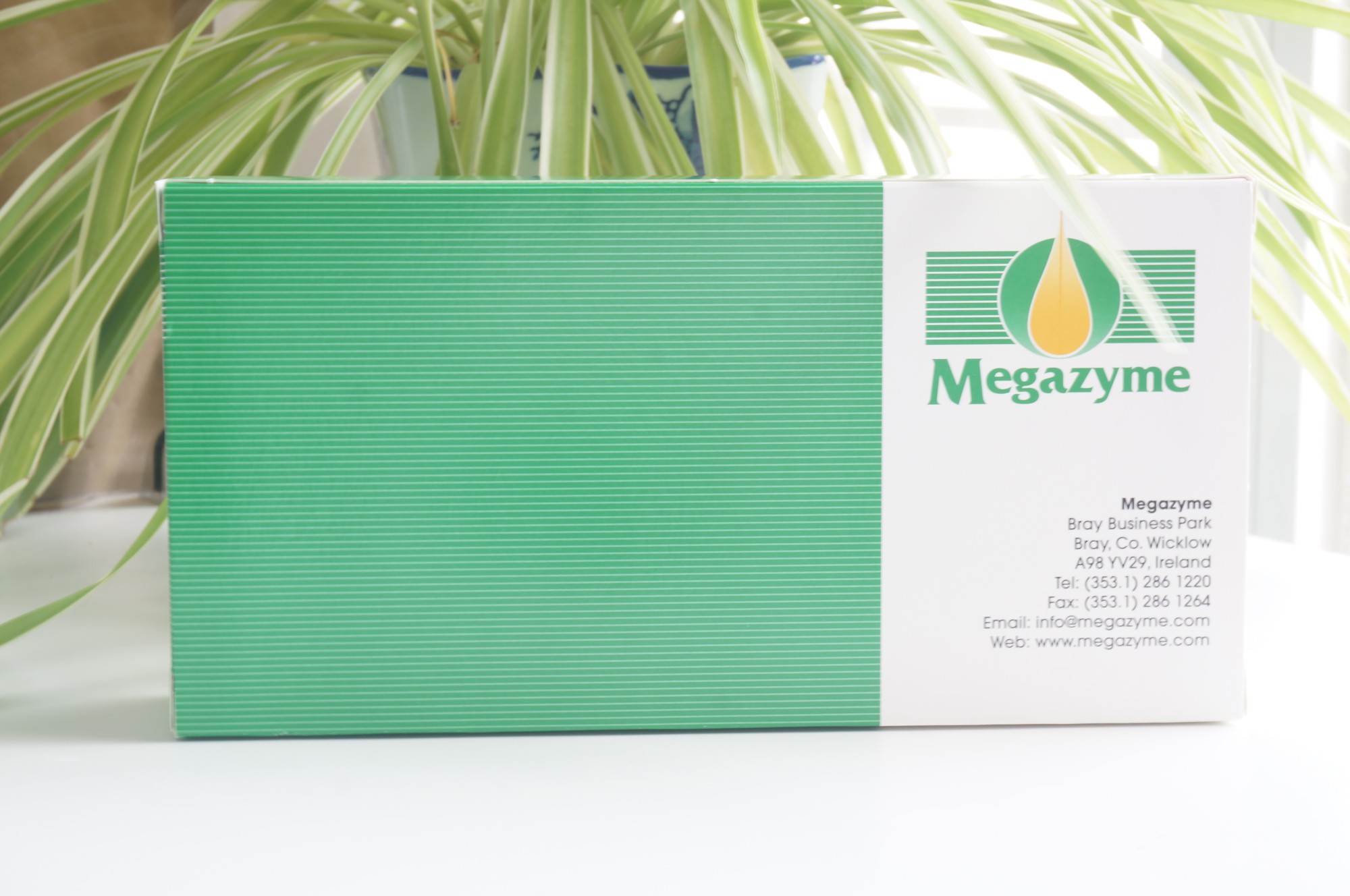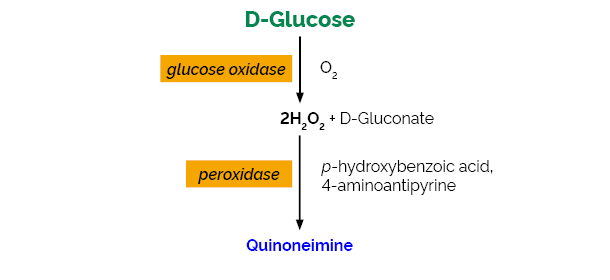D-葡萄糖测定试剂盒(GOPOD格式),K-GLUC

-
- 产地爱尔兰
- 品牌Megazyme
- 货号K-GLUC
- 规格660
详细描述
D-葡萄糖测定试剂盒(GOPOD格式),K-GLUC包含高纯度试剂,用于测量和分析谷物提取物中的D-葡萄糖,并与其他Megazyme试剂盒结合使用。
D-葡萄糖测定试剂盒(GOPOD格式),K-GLUC原理:

试剂盒规格: 660次
方法: 510 nm分光光度
总检测时间: 约20分钟
检测限: 100毫克/升
稳定性: >2年
应用实例: 葡萄酒,啤酒,果汁,软饮料,牛奶,果酱,营养食品,烘焙产品,糖果,水果和蔬菜,烟草,化妆品,药品,饲料,纸张和其他材料(例如生物培养物,样品等)。
方法认证: 在临床化学和食品分析中被广泛使用和接受
优势: 成本低,操作简单,试剂稳定
包含标准品及高纯度酶
制备后所有试剂均稳定> 12个月
D-葡萄糖[GOPOD法]检测试剂盒 D-Glucose (GOPOD Format) Assay Kit 货号:K-GLUC Megazyme试剂盒
- D-葡萄糖[GOPOD法]检测试剂盒
-
英文名:D-Glucose (GOPOD Format) Assay Kit
-
货号:K-GLUC
-
规格:660 assays per kit
- All reagents stable for > 12 months after preparation
- Very competitive price (cost per test)
- Simple format
- Standard included
- Ensure that you have tested the standard sample that is supplied with the Megazyme test kit.
- Send the results of the kit standard, blank samples and the results obtained for your sample, in the relevant MegaCalc spreadsheet (if available) to Megazyme (cs@megazyme.com). Where available the relevant MegaCalc spreadsheet can be downloaded from where the product appears on the Megazyme website.
- State the kit lot number being used (this is found on the outside of the kit box).
- State which assay format was used (refer to the relevant page in the kit booklet if necessary).
- State exact details of any modifications to the standard procedure that is provided by Megazyme.
- State the sample type and describe the sample preparation steps if applicable.
市场价: 3710元
分析物意义:常见食品组分,在某些情况下非常重要,如糖尿病产品 ![D-葡萄糖[GOPOD法]检测试剂盒 D-Glucose (GOPOD Format) Assay Kit 货号:K-GLUC Megazyme试剂盒](http://www.dnabct.com/wp-content/uploads/2022/09/20220924_632ed5c9ca3a0.jpg)
Megazyme检测试剂盒优点:选择简单可用的方法,葡萄糖氧化酶/过氧化酶 /己糖激酶/6-磷酸葡萄糖脱氢酶。试剂稳定
![D-葡萄糖[GOPOD法]检测试剂盒 D-Glucose (GOPOD Format) Assay Kit 货号:K-GLUC Megazyme试剂盒](http://www.dnabct.com/wp-content/uploads/2022/09/20220924_632ed5ca237e7.jpg)
The D-Glucose test kit contains high purity reagents for the measurement and analysis of D-glucose in cereal extracts and for use in combination with other Megazyme kits.
Colourimetric method for the determination of D-Glucose in
foodstuffs, beverages and other materials
Principle:
(glucose oxidase)
(1) D-Glucose + H2O + O2 → D-gluconate + H2O2
(peroxidase)
(2) 2H2O2 + p-hydroxybenzoic acid + 4-aminoantipyrine →
quinoneimine + 4H2O
Kit size: 660 assays
Method: Spectrophotometric at 510 nm
Reaction time: ~ 20 min
Detection limit: 100 mg/L
Application examples:
Wine, beer, fruit juices, soft drinks, milk, jam, dietetic foods, bakery
products, candies, fruit and vegetables, tobacco, cosmetics, pharmaceuticals,
feed, paper and other materials (e.g. biological cultures, samples, etc.)
Method recognition:
Widely used and accepted in clinical chemistry and food analysis
Advantages
Q1. There is an issue with the performance of the kit; the results are not as expected.
If you suspect that the Megazyme test kit is not performing as expected such that expected results are not obtained please do the following:
Q2. I have some questions regarding the Glucose Oxidase and peroxidase in the Glucose Assay Kit. At what optimal pH do the enzymes work? Does the sample that is added to the enzyme mix show incorrect results if it is outside a certain pH range?
The test is best run at pH 7.4. The reagent is buffered at this pH. Using different pH values will affect results, i.e. it may take longer to reach this end point; but the same end-point value should be obtained if not too far away from this pH value.
Q3. What is the linear range of the Glucose Assay Kit?
The test is set up to measure between 10 and 100 micrograms per assay (i.e. 0.1 mL of 0.1 to 1.0 mg/mL). You may prefer to use 3.0 mL of GOPOD reagent mixture plus 1.0 mL of sample; in this case the concentration range in the material being analysed (diluted) should be ~10 to 100 micrograms per mL. The test is linear up to an absorbance of 1.4 (final assay volume of 3.2 mL). If the final volume is 4.0 mL, then linearity will be up to about 1.0 absorbance units.
Q4. I have some questions on your Glucose Assay Kit. Is the colour stable at room temperature? Does the reaction continue if not read within 20 minutes?
The reaction is complete after approx. 15 min, and the colour is stable at temperatures of 20-50˚C for at least an extra hour.
Q5. Please let us know the lower limit of detection of measuring glucose using your Glucose Assay Kit (mg/mL).
1 microgram gives an absorbance of 0.01 if 3 mL of GOPOD are used. If 1 mL of GOPOD is used, 1 microgram gives an absorbance of 0.03 OD.
Q6. Should the pH of the sample be adjusted even for samples in acidic media?
The pH of the assay solution after the sample is added should be the same as that of the assay buffer that is supplied with the kit.
Low sample volumes (e.g. 0.1 mL) are not likely to affect the pH of the assay solution and therefore may not require pH adjustment.
Samples above 0.1 mL are more likely to affect the pH of the assay solution and therefore the pH of these samples should be adjusted as described in the data booklet, prior to addition to the assay.
Q7. Sometimes a negative absorbance change is obtained for the blank samples, is this normal? Should the real value (negative absorbance change) or “0” be used in the calculation of results?
Sometimes the addition of the last assay component can cause a small negative absorbance change in the blank samples due to a dilution effect and in such cases it is recommended that the real absorbance values be used in the calculation of results.
Q8. We stored the Glucose Assay Kit at 0-5°C for some weeks, because that is what is written on the package. Now we have noticed on some of the vials it says storage at –20°C. Can you tell me how long the products can be stored at 0-5°C without damage?
The kit enzymes can be stored at 0-5°C for up to 12 months, so they will be perfectly fine.
Q9. The temperature for the Glucose Assay Procedure (40 or 50˚C)-is this for incubation of the mix or reading the results at the spectrophotometer? Could I read the results at room temperature?
The temperature is just for the incubations. It is an end-point assay, so the spectrophotometer does not need to be temperature controlled.
Q10. Can oligosaccharides or polysaccharides be measured using the kit assay?
The kit assay will only measure the non-covalently linked monosaccharide.
Oligosaccharides or polysaccharides can be measured after hydrolysis to the monosaccharide. Generally acid hydrolysis can be achieved by boiling the oligo/polysaccharide in 1.3 M HCl for 1 h. It is recommended that scientific literature is consulted for information on hydrolysis conditions for the particular oligo/polysaccharide that is being measured.
